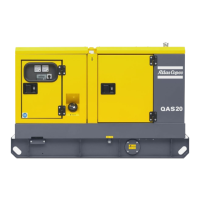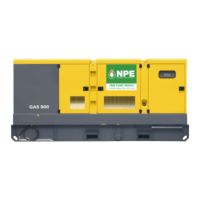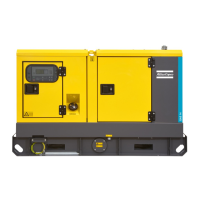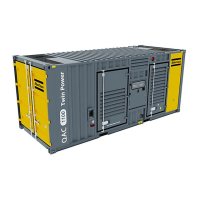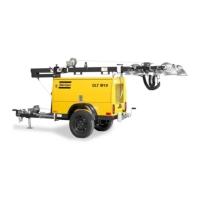QAS38 YdS TNV
16 2954 9020 00
5. Storage of the generator
5.1 Storage
– Store the generator in a dry, frost-free room which is well ventilat-
ed.
– Run the engine regularly, e.g. once a week, until it is warmed up. If
this is impossible, extra precautions must be taken:
– Consult the engine’s operator manual.
– Remove the battery. Store it in a dry, frost-free room. Keep the
battery clean and its terminals lightly covered with petroleum
jelly. Recharge the battery regularly.
– Clean the generator and protect all electrical components against
moisture.
– Place silicagel bags, VCI paper (Volatile Corrosion Inhibitor) or
another drying agent inside the generator and close the doors.
– Stick sheets of VCI paper with adhesive tape on the bodywork to
close off all openings.
– Wrap the generator, except the bottom, with a plastic bag.
5.2 Preparing for operation after storage
Before operating the generator again, remove the wrapping, VCI
paper and silicagel bags and check the generator thoroughly (go
through the checklist “Before starting”).
– Consult the engine’s operator manual.
– Check that the insulation resistance of the generator exceeds 5 MΩ.
– Replace the fuel filter and fill the fuel tank. Vent the fuel system.
– Reinstall and connect the battery, if necessary after being recharged.
– Submit the generator to a test run.
6. Checks and trouble shooting
6.1 Checking voltmeter P4
– Put a voltmeter in parallel with voltmeter P4 on the control panel.
– Check that the read-out of both voltmeters is the same.
– Stop the generator and disconnect one terminal.
– Check that the internal resistance of the voltmeter is high.
6.2 Checking frequency meter P5
– Run the unit at normal speed.
– Put a voltmeter in parallel with frequency meter P5.
– If the measured voltage is higher than 200 V, the frequency meter
has to work properly.
If not, remove the frequency meter, connect it with the mains
(240 V) and check that it indicates 60 Hz.
6.3 Checking ammeters P1, P2 en P3
– Measure during the load, by means of a clamp-on probe, the outgo-
ing current in the three phases.
– Compare the measured current with the current indicated on amme-
ters on the corresponding ammeters P1, P2 and P3. Both readings
should be the same.
Never perform a test run with connected power
cables. Never touch an electrical connector without
a voltage check.
When a failure occurs, always report what you expe-
rienced before, during and after the failure. Infor-
mation with regard to the load (type, size, power
factor, etc.), vibrations, exhaust gas colour, insula-
tion check, odours, output voltage, leaks and dam-
aged parts, ambient temperature, daily and normal
maintenance and altitude might be helpful to
quickly locate the problem. Also report any infor-
mation regarding the humidity and location of the
generator (e.g. close to sea).

